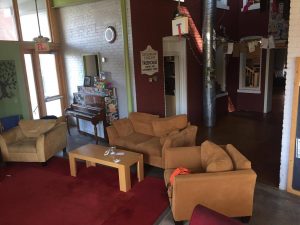
Common Area of the Treehouse
A space can be observed through ten different lenses, each of which offers unique insights to various attributes of that space. One of those lenses is examining a space through the eyes of ideology. The observer views characteristics as outputs of underlying values, ideas, and philosophies of a particular culture. I chose to view the common area of the Center for Sustainable Living, also known as the Treehouse, through the lens of ideology. I wanted to see if the individual objects, setup, and architecture of the space could communicate the culture of the Treehouse and it residents.
I first looked at and thought about the space itself, as in the walls and open spaces. Anyone entering the Treehouse must pass through the common area to access their own private room, which increases interactions among residents. The open spaces contain comfy, welcoming armchairs and sofas for people to lounge on and socialize. They are arranged in a rough circle to facilitate open discussion and participation. Furniture can be easily moved around the common space for flexibility in activities. The walls are covered with posters and artwork covering a diverse array of topics and mediums. Many of them focus on an issue of sustainability or social justice. A piano in the corner is covered with paint, photographs, newspaper cutouts, and glitter. Two metal ventilation pipes layered in a plethora of colorful stickers dominate the central space. Large windows with heavy dark curtains can be opened for a sunny and breezy open atmosphere, or they can be closed for a darker, more intimate and warmer space. The choices offered to residents in changing their surroundings creates a dynamic space that can shift to meet the needs of a social, active and creative group.
The various elements of the common space in the Center for Sustainable Living illustrate a philosophy and way of viewing and interacting with the world particular to the culture of the Treehouse residents. There is an obvious acceptance and encouragement of sustainable habits and thinking. Clothing is hung on clothing lines on the building’s ceiling. Banners and paintings feature trees, nature, slogans proclaiming action on climate change, and activism. But beyond a green lifestyle, collaboration is also celebrated in the Treehouse. By being encouraged to include their own stickers or artwork on the walls, residents grow to feel a responsibility to respect their home. The space becomes more personalized and friendly. The relaxed atmosphere and eclectic assortment of furniture and decorations supports a culture of expression and open communication. What others may view as disorder is utilized as living spaces for casual and creative thinking and learning.

The residents of the Treehouse cannot avoid displaying key components of their culture through the objects making up their common area. They are also in turn influenced by the space itself in how they interact with each other. The ideology of prioritizing eco-friendly living, creativity, cooperation, and self-expression is apparent in analyzing what is included in the common area.
